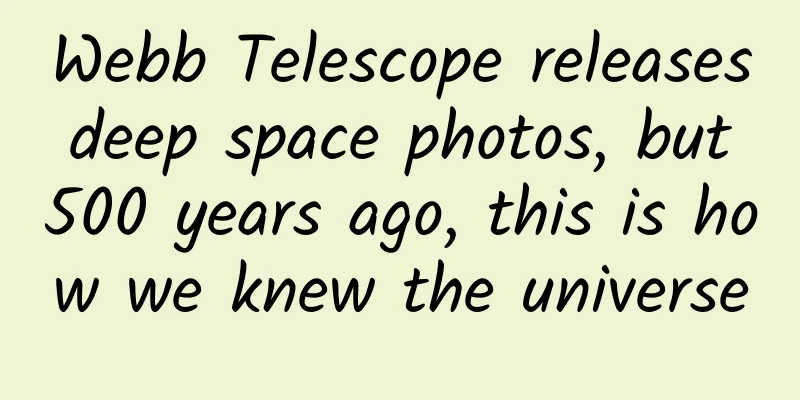Webb Telescope releases deep space photos, but 500 years ago, this is how we knew the universe

|
Some time ago, the Webb telescope released five full-color photos of the deep space. The pictures were magnificent and shocking. This is the first time that humans have captured galaxies at such a long distance so clearly. NASA's James Webb Space Telescope has provided the deepest, clearest infrared images of the distant universe yet. Webb's first deep field is of the galaxy cluster SMACS 0723, which is filled with thousands of galaxies - including the faintest objects ever observed in infrared light | Image credit: NASA Many years ago, the predecessor Hubble Space Telescope photographed this area, and scientists have studied every detail in this area. In Hubble's eyes, this area looks like this: In this image taken by the Hubble Space Telescope, the galaxy is relatively dim. The images captured by the Webb Space Telescope reveal many more details of the deep space. The hundreds of white, yellow, orange and red light spots, stripes, spirals and whirlpools in this image are just a small part of the universe. These starlights were emitted 13 billion years ago and are now captured by the Webb telescope. Compared with the Hubble version, the deep space field of the universe is clearer, deeper and more shocking! The Webb telescope also focuses people's attention on the ancient and distant depths of the universe again... With the development of science and technology, the starry sky has become clearer and more concrete in our eyes. However, before modern society, how did everyone understand the universe and nature? Since ancient times, our ancestors have been trying to copy the mysteries of nature that they have seen and heard, and make the thoughts in their brains "visible". Mathematicians look for the beauty of logic in works of art, astronomers use colored pens to draw the charm of the starry sky, and chemists use tables to show the laws of elements... If we build a gallery for science, which works would be the ones that use art to bear witness to the history of scientific development? Visiting Notice The gallery has four major exhibition halls: Astronomy, Geography and Biology, Mathematics, Physics and Chemistry. There is no specific exhibition order, no need for professional guides, and each work comes with its own explanation. Visitors do not need any special knowledge and there is no age limit. Anyone, young or old, who is curious and passionate about knowledge, nature, life, art and science can start to learn. One ticket is purchased for any number of visitors, and the ticket price is the price of the book. Brief Introduction of Some Exhibits Standing Man, from On the Fabric of the Human Body, 1543 When the ancients described the structure of humans, they only left words, no pictures. Vesalius drew the first frontal muscle system diagram of the human body. He hoped that these pictures would not only enable anatomists and surgeons to know the subtle structure of local organs of the human body, but also hope that they would show a complete muscle structure diagram that "only painters and sculptors are accustomed to think about." Vesalius made most of his anatomical specimens public, but the corpses he used were occasionally obtained from graves (he also admitted this in his book) or executed prisoners. Although the book On the Fabric of the Human Body is somewhat horrifying, it shows that Vesalius was full of awe for the Creator and was amazed that the human body designed by the Creator was so fascinating. Vesalius was only 28 years old when he published On the Fabric of the Human Body. The book was published in the same year as Copernicus' On the Revolutions of the Celestial Spheres. The importance of these two books in the history of science is comparable. A flea from Robert Hooke's Microscopic Atlas For the first time, human curiosity has shifted from the "very big" to the "very small". Many major discoveries in the history of science have benefited from the expansion of "vision". Humans invented instruments to see things that were previously invisible, and one of the most exciting creations is the microscope. The images revealed by the microscope can shock us, make us stand in awe of the natural world, and open our eyes to an unknown world: some of the most common things are here, they are complex and beautiful. Salute to Hooke! It was he who started the journey of discovery into the microscopic world, and it was he who made the microscopic world public with his extraordinary skills and unparalleled meticulousness! Von Humboldt's geographical study of equatorial flora, drawn in 1817 This map shows the variation in flora and fauna at different altitudes on the Chimborazo volcano in Ecuador. Humboldt used a cross section of the mountain (about 6.3 km high) as a reference for marking the altitude and distribution of the various flora he found, recording their names on the chart in Latin and by common names. The peaks in the image are Cotopaxi and Chimborazo, with Vesuvius at the side for comparison. The cloud heights and tree line are also clearly visible. Humboldt was a fine artist and a meticulous draftsman. He realized that a well-designed chart could replace lengthy data lists and tedious text descriptions. With a simple idea, beautiful design, and hard work, Humboldt set the standard for presenting ecological information. Heliocentric Model This is the heliocentric model proposed by Copernicus in his book On the Revolutions of the Celestial Spheres, published in 1543. In fact, this book was not widely circulated, and few people had read it when Copernicus died. However, it started the most famous "war of attrition" in human history, a war that would eventually overturn the classical "Ptolemaic cosmology" - the geocentric theory, and establish the heliocentric theory that has a solid position today. The heliocentric theory is undoubtedly the beginning of a great revolution in the history of human thought and science. The impact of this picture on the human worldview is undoubtedly greater than that of any other world model. Footprints left by bipedal primitive humans 3.6 million years ago The footprints contain a lot of interesting information about their owner. For example, the big toe is next to smaller toes, just like our toes today, but they are not separated, and are more like chimpanzee toes, so this big toe could not have been used in the same way as our toes. A series of depressions reveal the way the owner of the footprints walked: his/her heel touched the ground first, then the front toes rose up, and the heel left the ground again, and so on, just like how we walk. Between these footprints, there are the footprints of two primitive humans, one large and one small. The lighter person (because the footprints are relatively shallow) walked unevenly, with more weight on one side of the body - he/she might be holding a child - a family of three? Today, we can also leave the same marks in the sand when we walk on the beach in summer, but only a wonderful accident of nature can preserve them. Will there still be people here 3.6 million years from now? After viewing some of the exhibits, you will probably find that artworks that were originally intended to simply "display" sparks of thought and profound knowledge can actually subvert human cognition, influence our way of thinking, and even profoundly change the development of science. END Editor/Xiao Xitushuo |
<<: Why is this monkey's butt blue and mine isn't?
Recommend
Tesla's frequent car accidents have not stopped car companies from developing enthusiasm for autonomous driving technology, which is expected to enter a period of explosive growth in 2020
From the new car brand Tesla to the technology gia...
If the sunroof was not closed, would the owners of Nanjing Civic be in trouble?
Recently, a Nanjing Civic owner said that he was ...
Does being able to remember yesterday’s dreams mean you slept well? That’s not necessarily true!
Tuchong Creative Do you still remember the dream ...
Baidu Information Flow Delivery Manual
Baidu Information Flow is one of the main channel...
Why are other people’s information flow ads so effective? You can also do this...
Information flow advertising is developing in ful...
Do people who are "targeted" by cancer tend to have cold hands and feet?
Expert of this article: Hu Zhongdong, Chief Physi...
How to become a Douyin Blue V agent, how much does it cost and what are the conditions?
Recently, many people have added Feng Chao to inq...
How to do the preliminary promotion for a newly launched WeChat Mini Program? How to promote WeChat Mini Program?
How to do the preliminary promotion for a newly l...
Wild vegetables = green food? Don’t make these mistakes when eating wild vegetables!
The weather gradually warms up in March and April...
18 e-commerce online activities & gameplay collection
In today's environment where there is no e-co...
4 Effective Strategies to Increase App User Engagement
The definition of user engagement varies from pro...
Developer’s statement: This is how I learned GAN
Generative Adversarial Network, or GAN, is a well...
Short video marketing, save these strategies quickly!
In recent years, with the sharp increase in deman...
Riding on a log, ice skating, dragging an ice bed... the ancient people's "Winter Olympics" were actually like this!
2022 Beijing Winter Olympics Attracting the atten...
It's not that bagels are too expensive, but steamed buns are more cost-effective? What's the difference between the two?
Author: Fluent Not long ago, a short video went v...









